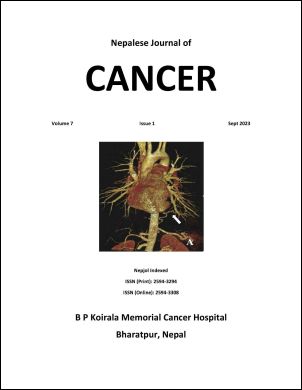Primary Cytoreductive Surgery versus Neoadjuvant Chemotherapy followed by Interval Cytoreductive Surgery for Advanced Epithelial Ovarian Cancer: A Retrospective Cohort Study
DOI:
https://doi.org/10.3126/njc.v7i1.60019Keywords:
epithelial ovarian cancer, morbidity, ; neoadjuvant therapy, ; survivalAbstract
Introduction: Epithelial ovarian cancer (EOC) represents about two-thirds of ovarian malignancies and usually presents with advanced disease. Primary cytoreductive (PCR) surgery is known to be the cornerstone of treatment of advanced EOC, but it might not always be feasible to obtain optimal cytoreduction. Neoadjuvant chemotherapy (NACT) has been proposed as an alternative approach. This study aims to compare the survival of patients, post-operative morbidity and the extent of cytoreduction that was achieved among the two treatment groups.
Methods: A retrospective cohort study was done in Bhaktapur Cancer Hospital of Nepal. All women who underwent surgical management for advanced epithelial ovarian cancer from 2016 to 2019 were included in the study and analyzed using SPSS version 23.
Results: Among 29 cases of advanced EOC, seven cases underwent PCR and 22 cases had NACT followed by interval cytoreduction (ICR). Optimal debulking was achieved in 85.7% of the cases in the PCR group and in 95.5% in the NACT+ICR group. Overall survival of >3 years in the PCR group was 42.9% while in the NACT group was 59.1%. Progression free survival (PFS) of >3 years was seen in 28.6% in the PCR group and in 45.5% in the NACT group.
Conclusions: The current study shows that NACT followed by ICR has better survival outcomes than PCR. Despite the limitations of the study, NACT + ICR can be considered a reasonable alternative to PCR in advanced EOC.
Downloads
Downloads
Published
How to Cite
Issue
Section
License
Copyright (c) 2023 Nepalese Journal of Cancer

This work is licensed under a Creative Commons Attribution 4.0 International License.
This license lets others distribute, remix, tweak, and build upon your work, even commercially, as long as NJC and the authors are acknowledged.
Submission of the manuscript means that the authors agree to assign exclusive copyright to NJC. The aim of NJC is to increase the visibility and ease of use of open access scientific and scholarly articles thereby promoting their increased usage and impact.




